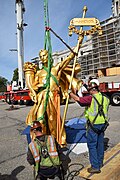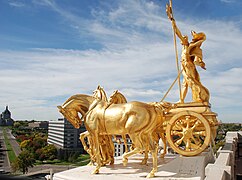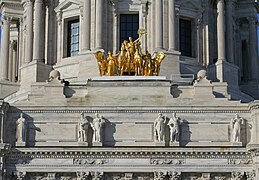Progress of the State

Progress of the State is the title of a group of sculptural figures that sits above the south portico, at the main entrance to the Minnesota State Capitol in Saint Paul, the state capital of the U.S. state of Minnesota.
The statuary group is in an arrangement known as a quadriga, consisting of a chariot pulled by four horses. Three human figures, two women and a man, are included. The sculpture, made by Daniel Chester French and Edward Clark Potter, was completed and raised to the roof of the capitol in 1906. The underlying armature is steel covered in copper. The exterior copper surface is gilded in gold leaf.
The quadriga arrangement is an ancient style of statue originating more than 2000 years ago in the Roman Republic. The male charioteer holds aloft a variation of a Roman Legion standard inscribed with the state name MINNESOTA.

In his design for the Capitol, Gilbert left out the classical triangular pediment favored in the Neoclassical and Beaux-Arts government architecture of the time and instead in its place an installed a quadriga monument at the base of the dome. The quadriga is also unusual in that it sits atop a building's portico, rather than upon a triumphal arch like most others. The inspiration for the Minnesota quadriga was statuary of Christopher Columbus standing in a four horse chariot guided by two maidens carrying staffs of victory that Daniel Chester French and Edward Clark Potter had modeled for the World's Columbian Exposition of 1893 in Chicago. Gilbert saw this quadriga group at and made plans to have artists adapt it for Minnesota.[1][2]
French's letter on adapting his earlier quadriga from the World's Columbian Exposition to Minnesota quadriga demonstrates the casualness allegorical meaning could be ascribed to a statue, and vice versa.
- "You will be glad to know that I have begun a model for the central figure (in the chariot) of the Quadriga. The other figures are already designed, as are the horses, since we are to follow the Quadriga which presided over the Columbian Arch at Chicago... The central figure, representing Columbus would, of course, not be appropriate for the State Capitol of Minnesota, so that a new design for this figure is necessary."
- "As the two figures leading the horses are female figures, I think the figure in the chariot should be a male figure," he wrote. "I think it should represent "Minnesota', if you think that a male figure can personify a state." [3]
The four horses in the Minnesota quadriga represent the classical elements of earth, air, fire, and water. Independently, the women represent industry and agriculture. Collectively, they represent civilization. In addition to personifying the state of Minnesota, the male charioteer holding a cornucopia (horn of plenty), a symbol of abundance and nourishment, represents prosperity.[4]
The Board had two options in how French could render the group. By French's estimates in 1896 he could cast it in bronze for $49,500 or make it from hammered copper for $36,000. The 1903 state appropriation set aside $35,000 for the group "to be executed in copper." French continued to hope to cast the Quadriga in bronze, as late as spring of 1906, but Gilbert communicated the Board's refusal: "However much they would like to use bronze they have not the money available for this purpose, as their appropriation is now all engaged in finishing up various minor items which are regarded as essential."[1][3]
In 1994 the group was taken down from the capitol roof for a year-long restoration procedure. The quadriga was reinstalled in 1995 and the figures have had several minor in situ reapplications of gold leaf since.
During a comprehensive restoration of the State Capitol building the figure of the charioteer was removed and lowered to the ground in 2014 to allow repairs to corrosion to the top surface of the chariot and was reinstalled in 2015.[5][6][7][8]

A closeup of the horses

Removal of charioteer

Removal of charioteer

Statue being reinstalled

Being reinstalled

Looking West

Looking East

The Quadriga and the Six Virtues

World's Columbian Exposition - Columbian Arch, and Columbus Quadriga
References[]
- ^ a b Thompson, Neil B. (2005). Minnesota's State Capitol: The Art and Politics of a Public Building. Minnesota Historical Society Press. pp. 75–76. ISBN 0-87351-085-2.
- ^ Roethke, Leigh (2005). Minnesota's Capitol: A Centennial Story. Afton Historical Society Press. pp. 62–63. ISBN 1-890434-67-1.
- ^ a b O'Sullivan, Thomas (1994). North Star Statehouse: An Armchair Guide to the Minnesota State Capitol. Pogo Press. pp. 58–59. ISBN 1-880654-07-5.
- ^ "Why the Quadriga sculpture at the state Capitol has pineapple wheels, and other fun facts". MinnPost. 2016-03-15. Retrieved 2021-03-22.
- ^ Salisbury, Bill (September 23, 2014). "State Capitol temporarily loses charioteer of the golden Quadriga". Pioneer Press. Retrieved 2021-01-29.
- ^ Cameron, Linda (March 3, 2019). "Quadriga: "The Progress of the State"". MNOpedia. Retrieved 2021-01-29.
- ^ Fitzgerald, Kilat (August 14, 2017). "Minnesota state capitol celebrates grand opening after restoration". La Crosse Tribune. Retrieved 2017-09-08.
- ^ West, Tom (August 19, 2017). "Notes from a visit to our restored State Capitol". dairylandpeach.com. Retrieved 2017-09-08.
| Wikimedia Commons has media related to Quadriga - The Progress of the State. |
External links[]
Coordinates: 44°57′18.81″N 93°6′7.9″W / 44.9552250°N 93.102194°W
- Minnesota State Capitol
- Outdoor sculptures in Minnesota
- 1906 sculptures
- Horses in art
- Copper sculptures in the United States
- Gold sculptures in the United States
- 1906 establishments in Minnesota
- Steel sculptures in Minnesota
- Sculptures by Daniel Chester French
- Architectural sculpture










